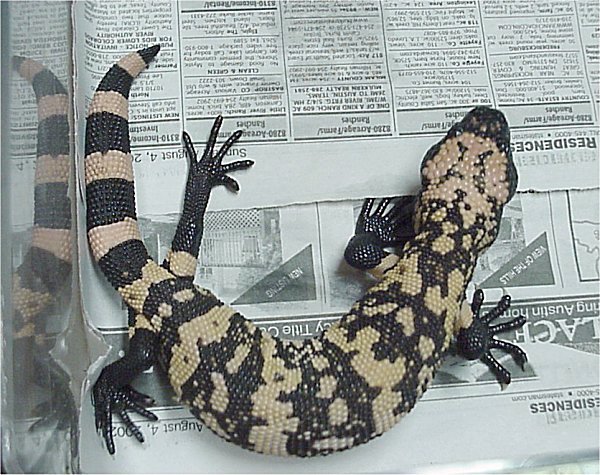- Heloderma
Taxobox
name = "Heloderma"

image_size = 240px
image_caption =Gila monster , "Heloderma suspectum"
fossil_range = LateCretaceous to Recent
regnum =Animal ia
phylum = Chordata
classis = Sauropsida
ordo =Squamata
subordo =Scleroglossa
familia = Helodermatidae
genus = "Heloderma"
genus_authority = Wiegmann,1829
subdivision_ranks = Species
subdivision = "Heloderma horridum"
"Heloderma suspectum""Heloderma", the only
genus of the family Helodermatidae, consists of venomouslizard s native to the southwesternUnited States ,Mexico and as far south asGuatemala . It includes two separatespecies , with sixsubspecies .Helodermatids (or beaded lizards) are large, stocky, slow-moving reptiles that prefer semi-
arid habitats. [ [http://animals.jrank.org/pages/3767/Gila-Monster-Mexican-Beaded-Lizard-Helodermatidae-PHYSICAL-CHARACTERISTICS.html Gila Monster and Mexican Beaded Lizard: Helodermatidae - Physical Characteristics] ] The tails are short and used as fat storage organs. They are covered with small, non-overlapping bead-like scales, withosteoderms on the underside of the body. Both species are dark in color, with yellowish or pinkish markings.cite book |editor=Cogger, H.G. & Zweifel, R.G.|author= Bauer, Aaron M.|year=1998|title=Encyclopedia of Reptiles and Amphibians|publisher= Academic Press|location=San Diego|pages= 156|isbn= 0-12-178560-2]Uniquely among lizards, members of the family are
venomous . [http://herpetology.com/helobite.txt] Unlikesnake s, venom glands are located in the lower jaw, and cannot be ejected under pressure. The venom is typically used only in defense, rather than in subduing prey, and the lizard must chew on its victim to work the venom into the flesh. Venom glands are believed to have evolved early in the lineage leading to the modern helodermatids, as there are indications of their presence even in the 65-million-year-old fossil genus "Paraderma". [Richard L. Cifelli, Randall L. Nydam. 1995. Primative, helodermatid-like platynotan from the early cretaceous of Utah. Herpetologica. 51(3):286-291.]Helodermatids are carnivorous, preying on rodents and other small mammals, and eating the eggs of birds and reptiles. They are
oviparous , laying large clutches of eggs.Taxonomy
Family Helodermatidae
* Genus "Heloderma"
** "Heloderma horridum",Beaded Lizard
*** "Heloderma horridum horridum " (Wiegmann, 1829)
*** "Heloderma horridum alvarezi" (Bogert & Martên del Campo, 1956)
*** "Heloderma horridum exasperatum" (Bogert & Martên Del Campo, 1956)
*** "Heloderma horridum charlesbogerti" (Campbell & Vannini, 1988)
** "Heloderma suspectum",Gila monster
*** "Heloderma suspectum cinctum" (Bogert & Martên Del Campo, 1956)
*** "Heloderma suspectum suspectum" (Cope, 1869)In captivity
"H. h. horridum", "H. h. exasperatum", and both subspecies of "H. suspectum" are frequently found in captivity, and are well represented in
zoo s throughout much of the world. They are often captive bred for the exotic animal trade, and can command high prices. The other two subspecies of "H. horridum" are extremely rare, and only a few captive specimens are known.Notes
External links
* [http://www.helodermahorridum.com/beaded_lizard.php About Beaded Lizards]
* [http://herpetology.com/heloderma.html Heloderma information]
* [http://www.tigr.org/reptiles/families/Helodermatidae.html Family Helodermatidae (Gila Monsters)]
Wikimedia Foundation. 2010.
